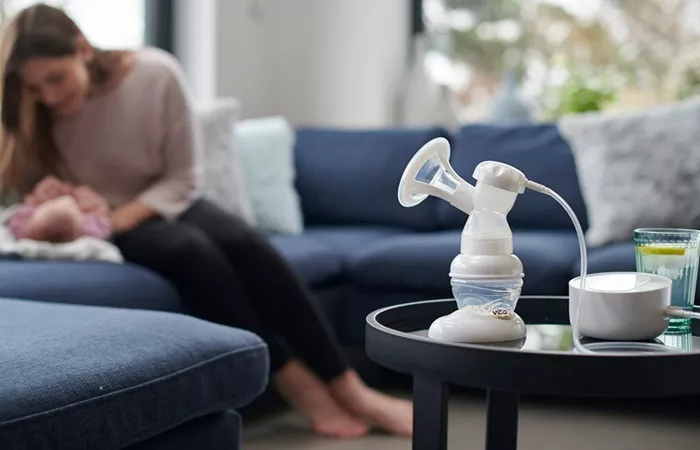A manual breast pump is a simple, hand-operated device used to extract milk from a mother’s breast. Many mothers use it to collect breast milk when they cannot feed their baby directly. It helps store milk for later feeding. Manual breast pumps work by creating suction on the breast to draw out milk. Unlike electric pumps, manual pumps do not need batteries or electricity. They are small, lightweight, and easy to carry. This article explains what a manual breast pump is, how it works, its parts, benefits, and tips for use. The language is simple to help everyone understand.
What Is a Manual Breast Pump?
A manual breast pump is a hand-held device that a mother uses to express milk from her breast. It usually has a funnel-shaped part called a breast shield that fits over the nipple and areola. When the mother squeezes or pulls a handle or lever, the pump creates suction. This suction gently pulls milk out of the breast and collects it in a bottle or container attached to the pump.
Manual pumps rely on the mother’s hand power to create suction. This means the mother controls the speed and strength of pumping. Many manual pumps have a lever or handle that is easy to operate with one hand. The milk flows into a bottle that can be stored or used to feed the baby.
How Does a Manual Breast Pump Work?
The pump works by creating a vacuum or suction on the breast. When the breast shield is placed over the nipple, squeezing the handle pulls air out of the pump. This lowers the pressure inside the pump and gently pulls milk from the milk ducts. When the handle is released, the suction stops, allowing milk to flow into the container. Repeating this squeezing and releasing creates a rhythm similar to a baby’s suckling.
This suction and release cycle helps stimulate milk flow and empty the breast. The mother can control the pressure and speed to find what feels comfortable and effective. This control may help some mothers feel more relaxed and encourage milk let-down.
Main Parts of a Manual Breast Pump
A manual breast pump usually has these main parts:
Breast Shield: A cone-shaped cup that fits over the nipple and areola to create a seal.
Pump Mechanism: A handle or lever that the mother squeezes to create suction.
Valve and Diaphragm: Parts that help control the suction and flow of milk.
Milk Container: A bottle or jar attached to the pump where the milk collects.
Sealing Components: Caps, rings, or disks used to close the container for storage.
Benefits of Using a Manual Breast Pump
Portability and Convenience
Manual pumps are small and light. They can easily fit into a purse or diaper bag. This makes them great for travel or pumping when away from home. They do not need batteries or power, so they work anywhere.
Cost-Effective
Manual breast pumps are usually less expensive than electric pumps. This makes them a good choice for mothers on a budget or those who only need to pump occasionally.
Quiet Operation
Manual pumps are very quiet because they do not have motors. This can be helpful if you want to pump discreetly in public or at work.
Control Over Suction
Because you operate the pump by hand, you control the suction strength and speed. This can help you find a comfortable rhythm and may reduce nipple discomfort.
Simple to Clean
Manual pumps usually have fewer parts than electric pumps. Many parts can be taken apart completely for easy cleaning and sterilizing. Some models can be boiled or sterilized safely.
Things to Consider When Using a Manual Breast Pump
Effort and Time
Manual pumping requires physical effort. You need to squeeze the handle repeatedly, which can be tiring. Pumping sessions may take longer than with electric pumps, especially if you pump both breasts.
Milk Flow and Efficiency
Manual pumps may not express milk as quickly or efficiently as electric pumps. Some mothers find it harder to empty their breasts fully with manual pumps.
Comfort and Fit
Choosing the right breast shield size is important. A shield that is too small or too large can cause discomfort or reduce milk flow. Many pumps come with different shield sizes or cushions for comfort.
Maintenance
Clean the pump parts after every use. Some parts can be boiled or sterilized to keep them safe and hygienic. Avoid using harsh cleaners or abrasive materials.
How to Use a Manual Breast Pump Effectively
- Wash your hands before pumping.
- Find a comfortable, quiet place to sit.
- Assemble the pump and place the breast shield over your nipple and areola.
- Squeeze the handle gently to start suction. Find a comfortable rhythm.
- Pump for about 15-20 minutes or until milk flow slows.
- Switch breasts if pumping one breast at a time.
- Store the milk in clean containers and refrigerate or freeze as needed.
- Clean and sterilize the pump parts after use.
When Is a Manual Breast Pump a Good Choice?
Manual breast pumps work well for mothers who pump occasionally or need a simple, portable option. They are also useful as a backup when electric pumps are not available. If you only need to express milk once in a while, a manual pump is often enough. However, if you pump frequently or need to express large amounts of milk quickly, an electric pump might be better.
Conclusion
A manual breast pump is a helpful tool for mothers to express and store breast milk. It is simple, portable, quiet, and affordable. By creating suction through hand operation, it mimics a baby’s natural suckling to release milk. While it requires more effort and time than electric pumps, it offers control and convenience. Choosing the right pump and using it properly can support breastfeeding and help mothers care for their babies even when they are apart.
Related topics:


